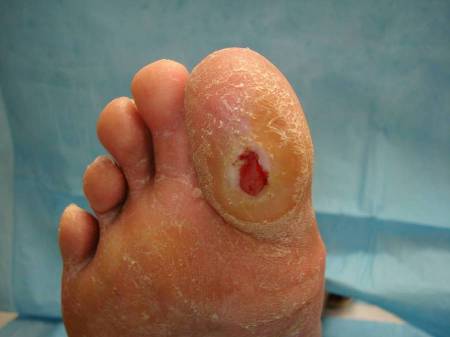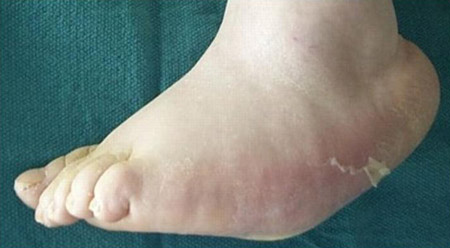Complications
Approximately 15% of people with diabetes develop a lower extremity ulcer at some point in the course of their condition.[271]
Minor noninfected wounds can be treated with nonirritating antiseptic solution, daily dressing changes, and foot rest. Therapeutic footwear that reduces plantar pressure can prevent plantar foot ulcer recurrence or worsening. The use of specialized therapeutic footwear is recommended for high-risk patients with diabetes, including those with loss of protective sensation (severe peripheral neuropathy), as well as those with foot deformities, ulcers, callus formation, poor peripheral circulation, or a history of amputation.[39][Figure caption and citation for the preceding image starts]: Plantar ulcer in a patient with type 1 diabetesFrom the collection of Dr Rodica Pop-Busui, University of Michigan [Citation ends]. [Figure caption and citation for the preceding image starts]: Charcot foot with ulcer in a patient with diabetesFrom the collection of Dr Rodica Pop-Busui, University of Michigan [Citation ends].
[Figure caption and citation for the preceding image starts]: Charcot foot with ulcer in a patient with diabetesFrom the collection of Dr Rodica Pop-Busui, University of Michigan [Citation ends].
More serious problems, such as foot deformities, infected lesions, and osteomyelitis, are best handled in consultation with specialists in diabetic foot care. For patients with high-risk feet (e.g., those on dialysis, those with Charcot foot, those with a history of prior ulcers or amputation, and those with peripheral artery disease [PAD]), an interprofessional approach facilitated by a podiatrist in conjunction with other appropriate team members is recommended.[120]
Infected foot ulcers usually require intravenous antibiotics, bed rest with foot elevation, and surgical debridement.
Most diabetic foot infections are polymicrobial, with aerobic gram-positive cocci, especially staphylococci, the most common causative organisms. Aerobic gram-negative bacilli are frequent co-pathogens in infections that are chronic or follow antibiotic treatment, and obligate anaerobes may be co-pathogens in ischemic or necrotic wounds.[93]
This is a major cause of patients with diabetes being admitted to the hospital.
Foot ulceration is a common precursor to amputation.
Approximately 7% to 20% of foot ulcers will eventually lead to amputation.[271]
People with impaired heart rate variability (cardiovascular autonomic neuropathy) have an increased risk of silent MI and death.
Charcot neuro-osteoarthropathy (CNO) is an uncommon progressive disorder resulting in severe destruction of the architecture of the foot.[Figure caption and citation for the preceding image starts]: Charcot foot in a patient with diabetesFrom the collection of Dr Rodica Pop-Busui, University of Michigan [Citation ends]. [Figure caption and citation for the preceding image starts]: Charcot foot with ulcer in a patient with diabetesFrom the collection of Dr Rodica Pop-Busui, University of Michigan [Citation ends].
[Figure caption and citation for the preceding image starts]: Charcot foot with ulcer in a patient with diabetesFrom the collection of Dr Rodica Pop-Busui, University of Michigan [Citation ends].
It is thought to develop because of a combination of factors: loss of protective sensation in the foot; increased blood flow to the foot (due to autonomic neuropathy) leading to bone loss and weak bones susceptible to injury; and unrecognized trauma.
Active CNO should always be considered in people with diabetes mellitus, neuropathy, and intact skin when there are relevant clinical findings which include an increase in temperature, edema, and/or redness of the foot, compared with the contralateral foot.[120]
Prompt knee high immobilization/off-loading must be undertaken while further diagnostic studies are performed to confirm or rule out active CNO. A plain x-ray of the foot and ankle should be performed in suspected active CNO.
Ascending temperature gradients (toe-knee) may be useful for comparison over time in a person with diabetes mellitus with bilateral active CNO and intact skin or with unilateral CNO and intact skin in those with one limb.
Use of this content is subject to our disclaimer